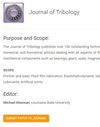油石加工及其对缸套表面组织的影响
IF 3
3区 工程技术
Q2 ENGINEERING, MECHANICAL
引用次数: 0
摘要
珩磨是一种基于磨料的加工工艺,通过分布在油石(也称珩磨石)上的大量随机晶粒与工件之间的微凸相互作用来去除材料。因此,以晶粒形态、尺寸、姿态和位置分布、突起高度等为特征的油石表面形貌,对于理解珩磨机理,建立准确的运动学模型,进一步分析油石性质对珩磨过程和珩磨表面纹理特征(包括槽密度)的影响,具有重要意义,粗糙度高度和平台/谷振幅。传统上,已经采用了两种典型的方法来建立基于磨料的切削工具的表面形貌:实验微观观察和根据假设的理想分布规律(如随机晶粒特征的高斯或均匀分布)进行的反向建模/模拟。第一种方法通常耗时,并且只测量相当小的区域内的表面地形;而第二种则高度依赖于假设的统计分布规律的真实性。为了克服这些弱点,本研究提出了一种函数正演方法(FFM),在连续模拟油石制造过程的基础上,准确预测油石表面形貌,避免分布假设和几何简化。该方法考虑了油石在珩磨过程中的五个重要随机特征,包括晶粒形态、尺寸、姿态、位置分布和晶粒磨损,以保证珩磨产生的表面形貌的可信度、真实性和通用性。基于油石表面形貌,提出了一种运动学模拟方法(KISM),分析了油石试样在不同搅拌时间下气缸膛珩磨表面的织构特征。因此,该方法将油石制造参数、油石表面形貌和珩磨表面纹理联系起来,通过更好地控制气缸孔的珩磨表面纹理,为油石制造工艺的参数优化提供了新的见解。本文章由计算机程序翻译,如有差异,请以英文原文为准。
Oilstone Processing and Its Impact on the Surface Texture of Cylinder Bore
Honing is one of the abrasive-based machining processes to remove material through the asperity interaction between numerous stochastic grains distributed on oilstone (also called honing stone) and workpiece. Therefore, the oilstone surface topography characterized with grain morphology, size, posture and position distribution, protrusion heights and etc., is of great significance to understand honing mechanism in terms of establishing an accurate kinematic model and further analyzing the oilstone property's impact on honing process and honed surface texture characteristics including groove density, roughness heights and plateau/valley amplitudes. Conventionally, two typical approaches have been employed to establish the surface topography of abrasive-based cutting tools: experimentally microscopic observation and backward modeling/simulation from the assumed ideal distribution laws such as Gaussian or uniform distribution for stochastic grain characteristics. The first method is usually time-consuming and only measures surface topography within rather small area; whereas the second one is highly dependent on the authenticity of assumed statistical distribution laws. To overcome these weaknesses, the research proposed a functional forward method (FFM) to accurately predict surface topography of oilstone based on simulating its manufacturing processes in succession to avoid distributional assumptions and geometrical simplification. The methodology takes into consideration five important stochastic characteristics of oilstone including grain morphology, size, posture, position distribution and grain wear during honing process, to guarantee the credibility, authenticity and generality of the surface topography generated from honing. Based on the oilstone surface topography, a kinematic simulation method (KISM) was proposed to analyze the honed surface texture characteristics of cylinder bore with oilstone samples under different stirring times. Therefore, the methodology bridges oilstone manufacturing parameters, oilstone surface topography and further the honed surface texture to provide a fresh insight into the parameter's optimization of oilstone manufacturing process by achieving a better control on the honed surface texture of cylinder bore.
求助全文
通过发布文献求助,成功后即可免费获取论文全文。
去求助
来源期刊
CiteScore
4.20
自引率
12.00%
发文量
117
审稿时长
4.1 months
期刊介绍:
The Journal of Tribology publishes over 100 outstanding technical articles of permanent interest to the tribology community annually and attracts articles by tribologists from around the world. The journal features a mix of experimental, numerical, and theoretical articles dealing with all aspects of the field. In addition to being of interest to engineers and other scientists doing research in the field, the Journal is also of great importance to engineers who design or use mechanical components such as bearings, gears, seals, magnetic recording heads and disks, or prosthetic joints, or who are involved with manufacturing processes.
Scope: Friction and wear; Fluid film lubrication; Elastohydrodynamic lubrication; Surface properties and characterization; Contact mechanics; Magnetic recordings; Tribological systems; Seals; Bearing design and technology; Gears; Metalworking; Lubricants; Artificial joints

 求助内容:
求助内容: 应助结果提醒方式:
应助结果提醒方式:


